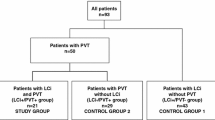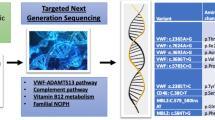Abstract
Background and Aim
Age at portal vein thrombosis (PVT) in liver cirrhosis (LC) carriers of the methylene tetrahydrofolate reductase (MTHFR) rs1801133 (C → T667 transition) polymorphism has never been addressed; we compared age at PVT in LC patients genotyped for the MTHFR and explored the interrelated clinical and laboratory factors predicting age at PVT.
Approach and Results
Retrospective cross-sectional cohort study. PVT participants: MTHFR CC n = 36, MTHFR CT n = 53, MTHFR TT n = 19; age, sex, age at PVT, Child–Pugh score, rs1799963 PT polymorphisms (G → A 20,210 transition), plasma HC and natural anticoagulants available for all participants. Age at PVT was lower in MTHFR TT than CT and CC (56 ± 13 vs. 57 ± 13 vs. 64 ± 9 years, p = 0.001); median (IQR) plasma HC was higher in MTHFR TT than in the other groups [(17 (9.4, 23.3) vs 13 (8,14.7) vs 11 (8.9, 12.7) μmol/l, p = 0.03)]. MTHFR TT, male gender and protein C predicted age at PVT (p = 0.02, p = 0.04 and p = 0.08); MTHFR TT and Child–Pugh score predicted plasma HC (p = 0.005 and p = 0.01) as well as low plasma protein C (p < 0.0001 and p = 0.0002). Plasma HC inversely related to protein C in the MTHFR TT group (p < 0.0001). Compound MTHFR TT with PT GA had lower age at PVT compared to MTHFR TT alone (49 ± 18 vs 58 ± 12 years).
Conclusions
MTHFR TT anticipates PVT associated with LC by an average of 8 years; MTHFR TT associates with severity of liver disease and to high plasma HC; the latter may contribute to the prematurity of PVT by interfering with the anticoagulant activity of protein C.

Similar content being viewed by others
References
Zaric BL, Obradovic M, Bajic V et al. Homocysteine and hyperhomocysteinaemia. Curr Med Chem 2019;26:2948–2961.
Zeng J, Zeng Q. Correlations between methylenetetrahydrofolate reductase gene polymorphisms and venous thromboembolism: A meta-analysis of 99 genetic association studies. Eur J Prev Cardiol 2019;26:120–134.
Ames PRJ, D’Andrea G, Marottoli V et al. Homozygous methylentetrahydrofolate reductase C667T genotype anticipates age at venous thromboembolism by one decade. Blood Coagul Fibrinolysis 2021;32:382–386.
Ma SD, Wang J, Bezinover D, Kadry Z, Northup PG, Stine JG. Inherited thrombophilia and portal vein thrombosis in cirrhosis: A systematic review and meta-analysis. Res Pract Thromb Haemost 2019;3:658–667.
Qi X, Yang Z, De Stefano V, Fan D. Methylenetetrahydrofolate reductase C677T gene mutation and hyperhomocysteinemia in Budd-Chiari syndrome and portal vein thrombosis: A systematic review and meta-analysis of observational studies. Hepatol Res 2014;44:E480-498.
Yerdel MA, Gunson B, Mirza D et al. Portal vein thrombosis in adults undergoing liver transplantation: risk factors, screening, management, and outcome. Transplantation 2000;9:1873–1881.
Kamei H, Nakamura T, Nagai S, Ishigami M, Hamajima N. Possible association between the methylenetetrahydrofolate reductase gene C677T polymorphism and pre-existing portal vein thrombosis in liver transplant recipients. Exp Clin Transplant 2016;14:313–316.
Tyagi N, Sedoris KC, Steed M, Ovechkin AV, Moshal KS, Tyagi SC. Mechanisms of homocysteine-induced oxidative stress. Am J Physiol Heart Circ Physiol 2005;6:2649–2656.
Schoneich C. Sulphur radical-induced redox modifications in proteins: analysis and mechanistic aspects. Antioxid Redox Signal 2017;26:388–405.
Rota S, McWilliam NA, Baglin TP, Byrne CD. Atherogenic lipoproteins support assembly of the prothrombinase complex and thrombin generation: modulation by oxidation and vitamin E. Blood 1998;91:508–515.
Ames PRJ, Tommasino C, D’Andrea G et al. Thrombophilic genotypes in subjects with idiopathic antiphospholipid antibodies–prevalence and significance. Thromb Haemost 1998;79:46–49.
Heinze G, Dunkler D. Five myths about variable selection. Transpl Int 2017;30:6–10.
Jin H, Cheng H, Chen W et al. An evidence-based approach to globally assess the covariate-dependent effect of the MTHFR single nucleotide polymorphism rs1801133 on blood homocysteine: a systematic review and meta-analysis. Am J Clin Nutr 2018;107:817–825.
Uhlén M, Fagerberg L, Hallström BM et al. Proteomics. Tissue-based map of the human proteome. Science 2015;347:1260419.
Adinolfi LE, Ingrosso D, Cesaro G et al. Hyperhomocysteinemia and the MTHFR C677T polymorphism promote steatosis and fibrosis in chronic hepatitis C patients. Hepatology 2005;41:995–1003.
Pineda-Tenor D, Gómez-Moreno AZ, Sánchez-Ruano JJ et al. MTHFR rs1801133 polymorphism is associated with liver fibrosis progression in chronic hepatitis C: A retrospective study. Front Med (Lausanne) 2020;7:582666.
Kalambokis GN, Christou L, Christodoulou D, Baltayiannis G. Haemostatic balance in patients with end-stage cirrhosis: low protein C is the predominant coagulant protein deficiency. Blood Coagul Fibrinolysis 2017;28:585–586.
Patil AG, Bihari C, Shewade HD, Nigam N, Sarin SK. Decreased protein C function predicts mortality in patients with cirrhosis. Int J Lab Hematol 2018;40:466–472.
Zhang D, Hao J, Yang N. Protein C and D-dimer are related to portal vein thrombosis in patients with liver cirrhosis. J Gastroenterol Hepatol 2010;25:116–121.
Lentz SR, Sadler JE. Inhibition of thrombomodulin surface expression and protein C activation by the thrombogenic agent homocysteine. J Clin Invest 1991;88:1906–1914.
Cattaneo M, Franchi F, Zighetti ML, Martinelli I, Asti D, Mannucci PM. Plasma levels of activated protein C in healthy subjects and patients with previous venous thromboembolism: relationships with plasma homocysteine levels. Arterioscler Thromb Vasc Biol 1998;18:1371–1375.
Undas A, Williams EB, Butenas S, Orfeo T, Mann KG. Homocysteine inhibits inactivation of factor Va by activated protein C. J Biol Chem 2001;276:4389–4397.
Nery F, Carneiro P, Correia S et al. Systemic inflammation as a risk factor for portal vein thrombosis in cirrhosis: a prospective longitudinal study. Eur J Gastroenterol Hepatol 2021;33:e108–e113.
Xing Y, Tian Z, Jiang Y et al. A practical nomogram based on systemic inflammatory markers for predicting portal vein thrombosis in patients with liver cirrhosis. Ann Med 2022;54:302–309.
Wu C, Lu W, Zhang Y et al. Inflammasome activation triggers blood clotting and host death through pyroptosis. Immunity 2019;50:1401–1411.
Wang J, Dong R, Zheng S. Roles of the inflammasome in the gut-liver axis. Mol Med Rep 2019;19:3–14.
Yang X, Cheng X, Tang Y et al. Bacterial endotoxin activates the coagulation cascade through gasdermin D-Dependent phosphatidylserine exposure. Immunity. 2019;51:983–996.
Zabot GP, Carvalhal GF, Marroni NP et al. Glutamine prevents oxidative stress in a model of portal hypertension. World J Gastroenterol 2017;23:4529–4537.
Voutilainen S, Morrow JD, Roberts LJ 2nd et al. Enhanced in vivo lipid peroxidation at elevated plasma total homocysteine levels. Arterioscler Thromb Vasc Biol 1999;19:1263–1266.
Basili S, Carnevale R, Nocella C et al. PRO-LIVER collaborators. Serum albumin is inversely associated with portal vein thrombosis in cirrhosis. Hepatol Commun 2019;3:504–512.
Seen S. Chronic liver disease and oxidative stress - a narrative review. Expert Rev Gastroenterol Hepatol 2021;15:1021–1035.
Ames PRJ, Guardascione M, Batuca JR, Arcaro A, Gentile F, Amitrano L. Nitric oxide metabolites, nitrative stress, and paraoxonase activity in hepatopulmonary syndrome. Scand J Gastroenterol 2016;51:73–77.
Wang H, Sun Q, Zhou Y et al. Nitration-mediated deficiency of cystathionine β-synthase activity accelerates the progression of hyperhomocysteinemia. Free Radic Biol Med 2017;113:519–529.
Niu W, Wang J, Qian J et al. Allosteric control of human cystathionine β-synthase activity by a redox active disulphide bond. J Biol Chem 2018;293:2523–2533.
Amitrano L, Guardascione MA, Ames PR, Margaglione M et al. Increased plasma prothrombin concentration in cirrhotic patients with portal vein thrombosis and prothrombin G20210A mutation. Thromb Haemost 2006;95:221–223.
Hickey SE, Curry CJ, Toriello HV. ACMG Practice Guideline: lack of evidence for MTHFR polymorphism testing. Genet Med 2013;15:153–156.
Deloughery TG, Hunt BJ, Barnes GD, Connors JM. A call to action: MTHFR polymorphisms should not be a part of inherited thrombophilia testing. Res Pract Thromb Haemost 2022;6:e12739.
Martens K, McMurry HS, Koprowski S et al. Anticoagulation in Cirrhosis: Evidence for the treatment of portal vein thrombosis and applications for prophylactic therapy. J Clin Gastroenterol. 2022. https://doi.org/10.1097/MCG.0000000000001713 (PMID: 35537133).
Gaballa D, Bezinover D, Kadry Z et al. Development of a model to predict portal vein thrombosis in liver transplant candidates: The portal vein thrombosis risk index. Liver Transpl 2019;25:1747–1755.
Gabr MA, Bessa SS, El-Zamarani EA. Portal vein thrombosis in Egyptian patients with liver cirrhosis: Role of methylenetetrahydrofolate reductase C677T gene mutation. Hepatol Res 2010;40:486–493.
Smith DE, Hornstra JM, Kok RM, Blom HJ, Smulders YM. Folic acid supplementation does not reduce intracellular homocysteine, and may disturb intracellular one-carbon metabolism. Clin Chem Lab Med 2013;51:1643–1650.
Ray JG, Kearon C, Yi Q, Sheridan P, Lonn E. Heart outcomes prevention evaluation 2 (HOPE-2) Investigators. Homocysteine-lowering therapy and risk for venous thromboembolism: a randomized trial. Ann Intern Med 2007;146:761–767.
Ven Heijer M, Willems HP, Blom HJ et al. Homocysteine lowering by B vitamins and the secondary prevention of deep vein thrombosis and pulmonary embolism: a randomized, placebo controlled, double-blind trial. Blood 2007;109:139–144.
Author information
Authors and Affiliations
Contributions
All authors contributed to the study conception and design. PRJA, FG and VM designed the study; PRJA, LI and AA collected the data; PRJA and MM analyzed the data. The first draft of the manuscript was written by Paul RJ Ames, all authors provided comments on the first draft that was finalized by FG and MM. All authors read and approved the final manuscript.
Corresponding author
Ethics declarations
Conflict of interest
None of the authors has any financial or non-financial competing interest to declare.
Ethical approval
At the time of their attendance for the thrombophilia screen patients gave informed and written consent to the use and storage of their genetic material and of their anonymized clinical information as per approval of the local Ethics Committee.
Additional information
Publisher's Note
Springer Nature remains neutral with regard to jurisdictional claims in published maps and institutional affiliations.
Rights and permissions
Springer Nature or its licensor holds exclusive rights to this article under a publishing agreement with the author(s) or other rightsholder(s); author self-archiving of the accepted manuscript version of this article is solely governed by the terms of such publishing agreement and applicable law.
About this article
Cite this article
Ames, P.R.J., D’Andrea, G., Arcaro, A. et al. Liver Cirrhosis Patients Homozygous for MTHFR C677T Develop Portal Vein Thrombosis 8 Years Earlier Than Wild Type. Dig Dis Sci 68, 1332–1338 (2023). https://doi.org/10.1007/s10620-022-07666-7
Received:
Accepted:
Published:
Issue Date:
DOI: https://doi.org/10.1007/s10620-022-07666-7




